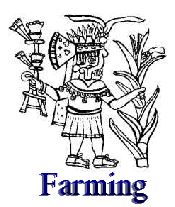
Cultivation of the soil was the basis of Aztec life. In the new chinampa zones, considerable numbers of farmers were resident tenants tied to the land of estates, who paid "rent" in kind to owners residing in Tenochtitlan. These laborers were essentially dependent on the state and were supervised by state-appointed administrators. The estates were owned by the pipiltin (nobles) or the tlatoani himself, and were also awarded to distinguished warriors whose tenure tended to become hereditary. Food was supplied to Tenochtitlan by tenant farmers living outside the traditional calpultin framework, and additional food was acquired from non-tenant calpultin farmers who brought their surplus to market. A third source of food was provided by the tribute exacted from conquered communities.
Tenochtitlan was growing and these sources of food were becoming increasingly inadequate. By the middle of the 15th century the city had a population estimated between 150,000 and 2000,000, five times larger than Tezcoco. Yet it lacked a chinampa zone immediately attached to the city. By the 15th century, during the reign of Montezuma I, older chinampa zones were incorporated in larger drainage and water control systems that included large-scale construction of new chinampa fields. Central control of the water supply was essential to ensure good harvest throughout the year. In the dry months, irrigation of plants was done by hand, water being carried in containers from the canals to the seedbeds on the chinampa platform. Chinampa gardens were fertilized with human excrement collected in canoes from Tenochtitlan and transported to the field. Excrement was also sold in pots in the Tlateloco market. Aqueducts were used to effectively permit permant year-round settlement, while the vast terrace systems were used to create new farmland, whose crops were still largely dependent on seasonal rain.
Aztec farmers inherited knowledge of plants that had developed over thousands of years. In ancient Mexico, the dog, turkey, and duck were the only domesticated livestock; sheep, goats, pigs, cattle, and horses were introduced by the Spanish. The basic diet of the Aztecs was vegetarian, supplemented by game animals, fish, turkeys and other birds, and various kinds of insects. Maize was the universal staple, and the basis of the economy. Their diet also featured a diversity of chiles, with a wide range of flavors and hotness.

Farming